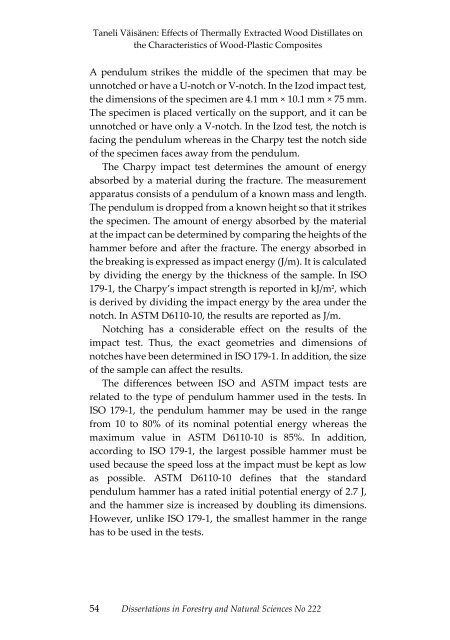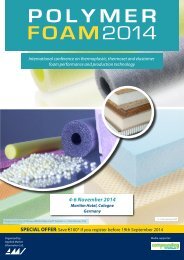Dissertations in Forestry and Natural Sciences
24lYKFN
24lYKFN
Create successful ePaper yourself
Turn your PDF publications into a flip-book with our unique Google optimized e-Paper software.
Taneli Väisänen: Effects of Thermally Extracted Wood Distillates on<br />
the Characteristics of Wood-Plastic Composites<br />
A pendulum strikes the middle of the specimen that may be<br />
unnotched or have a U-notch or V-notch. In the Izod impact test,<br />
the dimensions of the specimen are 4.1 mm × 10.1 mm × 75 mm.<br />
The specimen is placed vertically on the support, <strong>and</strong> it can be<br />
unnotched or have only a V-notch. In the Izod test, the notch is<br />
fac<strong>in</strong>g the pendulum whereas <strong>in</strong> the Charpy test the notch side<br />
of the specimen faces away from the pendulum.<br />
The Charpy impact test determ<strong>in</strong>es the amount of energy<br />
absorbed by a material dur<strong>in</strong>g the fracture. The measurement<br />
apparatus consists of a pendulum of a known mass <strong>and</strong> length.<br />
The pendulum is dropped from a known height so that it strikes<br />
the specimen. The amount of energy absorbed by the material<br />
at the impact can be determ<strong>in</strong>ed by compar<strong>in</strong>g the heights of the<br />
hammer before <strong>and</strong> after the fracture. The energy absorbed <strong>in</strong><br />
the break<strong>in</strong>g is expressed as impact energy (J/m). It is calculated<br />
by divid<strong>in</strong>g the energy by the thickness of the sample. In ISO<br />
179-1, the Charpy’s impact strength is reported <strong>in</strong> kJ/m 2 , which<br />
is derived by divid<strong>in</strong>g the impact energy by the area under the<br />
notch. In ASTM D6110-10, the results are reported as J/m.<br />
Notch<strong>in</strong>g has a considerable effect on the results of the<br />
impact test. Thus, the exact geometries <strong>and</strong> dimensions of<br />
notches have been determ<strong>in</strong>ed <strong>in</strong> ISO 179-1. In addition, the size<br />
of the sample can affect the results.<br />
The differences between ISO <strong>and</strong> ASTM impact tests are<br />
related to the type of pendulum hammer used <strong>in</strong> the tests. In<br />
ISO 179-1, the pendulum hammer may be used <strong>in</strong> the range<br />
from 10 to 80% of its nom<strong>in</strong>al potential energy whereas the<br />
maximum value <strong>in</strong> ASTM D6110-10 is 85%. In addition,<br />
accord<strong>in</strong>g to ISO 179-1, the largest possible hammer must be<br />
used because the speed loss at the impact must be kept as low<br />
as possible. ASTM D6110-10 def<strong>in</strong>es that the st<strong>and</strong>ard<br />
pendulum hammer has a rated <strong>in</strong>itial potential energy of 2.7 J,<br />
<strong>and</strong> the hammer size is <strong>in</strong>creased by doubl<strong>in</strong>g its dimensions.<br />
However, unlike ISO 179-1, the smallest hammer <strong>in</strong> the range<br />
has to be used <strong>in</strong> the tests.<br />
54 <strong>Dissertations</strong> <strong>in</strong> <strong>Forestry</strong> <strong>and</strong> <strong>Natural</strong> <strong>Sciences</strong> No 222



